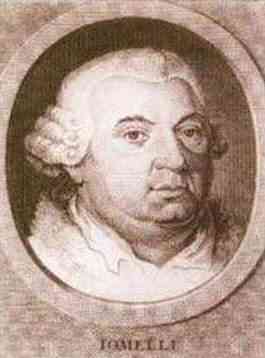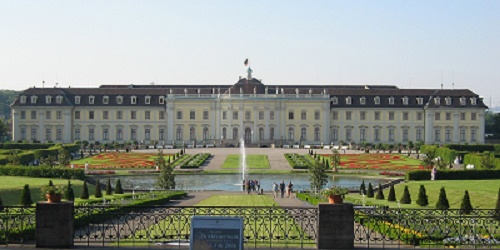


Niccolò Jommelli
Source:
Anacardiaceae
Born on 10 Sep 1714 in Aversa, Italy, though Niccolò Jommelli's star didn't shine quite so bright as his immediate contemporaries, Christoph Gluck and Niccolò Piccinni, he was yet highly popular throughout his career for his operas staged in Italy, Venice and Germany. Jommelli had a linen merchant for a father. In 1725 Jommelli was enrolled into the Sant'Onofrio building of the Naples Conservatory of Music. Three years later he was transferred to the Pietà dei Turchini building where he studied for several years.
Jommelli composed for the whole spectrum of music from cantatas to instrumental sonatas, concertos, and sinfonias, to sacred hymns, masses and oratorios. His greatest body of works, however, were operas, of which his first in 1737 was a considerable success, that a buffa (comedy) called 'L'errore amorosa' performed at the Teatro Nuovo in Naples. He followed that later the next year with 'Odoardo'. His first seria, 'Ricimero re di Goti' ('Ricimero King of the Goths'), was premiered in Rome on 16 January 1740 at the Teatro Argentina. Jommelli then obtained the protection of Duke Henry Benedict of York who, upon becoming a cardinal, appointed Jommelli to the Vatican.
Jommelli first performed 'Ezio' in Bologna on 29 April 1741, that with libretto by Metastasio. "Ezio" refers to the 5th century Roman general, Aetius, who battled against threats to Rome, particularly Attila the Hun. Jommelli would revise 'Ezio' for the fourth time thirty years later in 1771. It isn't known when Jommelli composed what IMSLP titles 'Harpsichord Concerto in D major' which is also seen as 'Piano Concerto in D major'. Unable to find the original MS for the exact title, harpsichord may be more correct. Though invented in 1700, the piano (more technically called fortepiano or pianoforte at Jommelli's time) during Jommelli's period was yet too underdeveloped for some composers. The piano was held to be, in so many words, a "promising" instrument for most of the eighteenth century. But the standard workhorse in general remained the old reliable harpsichord. One would think such to be true of Jommelli as well due to the types of music he composed, for which an instrument "loud" ("forte") "soft" ("piano") would be distractive. Nevertheless, 'Harpsichord Concerto in D major' is rendered 'Piano Concerto in D major' by the curator of the entry below whether written for piano or not. As commented, it isn't known when Jommelli wrote this work. I slip it in here only because IMSLP mentions that it quotes or is quoted by a passage in 'Ezio' above.
'Harpsichord Concerto in D major' Niccolò Jommelli
Date unknown: shares a passage with 'Ezio' of 1741
I Solisti Partenopei / Ivano Caiazza
Piano: Antonella Cristiano
Jommelli's opera seria, 'Demofoonte', arrived in 1743 which he would revise four times to as late as 1770. 'Demofoonte' is a very popular opera with a libretto by Metastasio first set to music by Antonio Caldara in 1733. It has been staged to the music of numerous composers over the years.
'Non Odi Consiglio' ('Don't Despise Advise') Aria by Niccolò Jommelli
From the opera 'Demofoonte' Adrasto from Act 3
Premiere 13 June 1743 at the Teatro degli Obizzi in Padua
Revised by Jommelli 1753 / 64 / 70
Stuttgart Baroque Ensemble / Frieder Bernius in Schwetzingen 1995
Soprano: Max-Emmanuel Cencic
In 1745 Jommelli became director of music at the Ospedale degli Incurabili in Venice. In 1747 he staged 'Didone Abbandonata' at the Argentina Theatre in Rome, that again with libretto by Metastasio. That work concerns the love affair between Trojan hero, Aeneas, and Dido, founder and queen of Carthage. Jommelli would revise that opera for the third time in 1763. Come his comic intermezzo a tre voci, 'Don Trastullo'. This work concerns one Don Trastullo, a bass singer, put against two lovers, the soprano, Arsenia, and the tenor, Giambarone. It premiered in Rome during the Carnival of 1749. Another comic intermezzo arrived in 1750 titled 'L'Uccellatrice' ('The Fowler' / 'The Bird Catcher'). This work also has three characters al though one, Lesbino, is silent. The others are the baritone, Don Narciso, who falls in love with the fowler, Mergellina. Libretto in Italian.
'O Che Fiamma' ('Oh What a Flame') Aria by Niccolò Jommelli
From the intermezzo 'Don Trastullo'
Premiere during Carnival of 1749 in Rome
Cappella de' Turchini / Antonio Florio / 2002
Bass: Giuseppe Naviglio
'L'Uccellatrice' ('The Fowler') Intermezzo by Niccolò Jommelli
Premiere 6 May 1750 at the Teatro San Samuele in Venice
Libretto possibly by Carlo Goldoni
Piccola Orchestra Veneta / Marco Bellussi
In 1753 Jommelli went north where the action was in Stuttgart, there becoming kapellmeister to Duke Charles Eugene of Württemberg. Among his sacred works is 'Missa Defunctorum' ('Missa Pro Defunctis'), a requiem authored upon the death of Charles' mother, Princess Maria Augusta of Thurn und Taxis in 1756. Regardless this sad pall at Charles' palace, Jommelli welcomed the change of atmosphere from Venice to Germany, a number of his operas to be performed at the private theatre of Charle's Ludwigsburg Palace including 'Il Vologeso' on Charles' birthday on 11 of February 1766. 'Il Vologeso' is the story of a love triangle between Parthian king, Vologases IV, the Roman general, Lucius Verus, and Berenice, queen of Armenia. Its libretto was written by Mattia Verazi based on an earlier text by Metastasio from a text by Apostolo Zeno's 'Lucio Vero'.

Ludwigsburg Palace of Duke Charles Eugene of Württemberg
Southern Germany in the Duchy of Swabia
Source: Wikipedia
'Missa Defunctorum' ('Missa Pro Defunctis') Requiem mass by Niccolò Jommelli
Composed 1756 upon the death of the mother of Duke Charles Eugene, Maria Augusta
Il Gardellino Vocal Ensemble & Baroque Orchestra
'Il Vologeso' Opera by Niccolò Jommelli
Premiere 11 Feb 1766 at the Schlosstheater of Duke Charles Eugene in Ludwigsburg
Occasion: birthday of Duke Charles Eugene of Württemberg
Libretto by Mattia Verazi
Stuttgarter Kammerorchester / Frieder Bernius
Jommelli returned to Naples in 1768 where his latter opera, 'Armida Abbandonata' ('Armida Abandoned'), premiered in 1770. This work concerns the confrontation between the Saracen sorceress, Armida, and the Crusading knight, Rinaldo. Libretto in Italian. I wrap this presentation of Jommelli with his 'Sinfonia di Salterio' aka 'Sinfonia in G major' for the reason that it isn't known when he composed it. In the rendition below, Karl-Heinz Schickhaus plays a chromatic dulcimer (hackbrett), developed in the 1930s from the hammered dulcimer, which originated in the Middle East circa 1000 AD, soon finding its way to Europe. The dulcimer was, is, called a salterio in Latin-speaking countries (Italy, Spain, Mexico, Portugal, Brazil).
'Armida Abbandonata' Opera by Niccolò Jommelli
Premiere 31 May 1770 at the Teatro di San Carlo in Naples
Revised to premiere on 30 March 1773 at the Teatro da Ajuda in Lisbon
Libretto by Francesco Saverio de Rogatis
Les Talens Lyriques / Christophe Rousset
'Sinfonia G-Dur für Salterio' ('Sinfonia in G major') Symphony by Niccolò Jommelli
Composed for dulcimer on date unknown
Münchener Kammerorchester / Hans Stadlmair
Hackbrett (dulcimer also called salterio): Karl-Heinz Schickhaus (arrangement)
Though Jommelli was considered old-fashioned (by Mozart, for one) by the time he died in Naples on 25 August 1774, he was nonetheless indubitably a great among the greatest of 18th century composers.
Sources & References for Niccolò Jommelli:
VF History (notes)
Wikipedia Italiano
Audio of Jommelli:
Classical Archives
Hyperion
Naxos
Presto
Compositions / Works: Corpus:
IMSLP
(operas 1740-1774)
Università di Bologna
(operas 1737-1751)
Compositions / Works: Individual (mentioned herein):
Armida Abbandonata (opera / 1770 revised by Jommelli
73):
Demofoonte (opera / 1743 revised by
Jommelli 53/64/70):
Missa Defunctorum aka Missa Pro Defunctis
(requiem / 1756):
Cambridge University
Carus Verlag
L'Uccellatrice (intermezzo / 1750):
Opera Scotland
Wikipedia
Il Vologeso (opera / 1766)
Manuscripts (digital copies):
Gallica
Internet Archive
OPEN MLOL
Don Trastullo
(intermezzo premiering in Rome 1749)
Ricimero re di Goti
(opera seria premiering
in Rome 1740) (alt)
Recordings of Jommelli: Catalogs: All Music Discogs HOASM Music Brainz RYM
Recordings of Jommelli: Select:
Concerto Con Salterio (Münchener Kammerorchester / Hans Stadlmair / arrangement and dulcimer by Karl-Heinz Schickhaus / Tudor / 1978)
(opera 1747/49/63 / Stuttgarter Kammerorchester / Frieder Bernius / Orfeo)Don Trastullo (intermezzo 1749 / Cappella della Pieta de'Turchini / Antonio Florio / 2002):
All Music Classical Archives Robert Levine Presto Qobuz
Requiem & Miserere (Il Gardellino Vocal Ensemble & Baroque Orchestra / 2020)
L'Uccellatrice (intermezzo 1750 / Orchestra da Camera Milano Classica / Vanni Moretto / 2002)
:Il Vologeso (opera 1766 / by the Mozartists / Ian Page / London / 2016):
Chandos Hyperion Planet Hugill
Il Vologeso (opera 1766 / by the Stuttgart Chamber Orchestra / Frieder Bernius / Orfeo / 1997)
Scores / Sheet Music: IMDb Musicalics (vendor)
Further Reading:
Helmut Hell (Die neapolitanische Opernsinfonie in der ersten Hälfte des 18. Jahrhunderts / 1971)
Bibliography:
Mauricio Dottori (The Church Music of Davide Perez and Niccolò Jommelli / DeArtes - UFPR / 2008)
(Jommelli’s ‘tenacious memory’ / Studi musicali / Vol.38 No.2 / 2009)Wolfgang Hochstein (Die Kirchenmusik von Niccolò Jommelli: (1714-1774) / Hildesheim / 1984)
Authority Search: VIAF
Other Profiles:
Angela Romagnoli (Treccani)
hmrproject (at) aol (dot) com